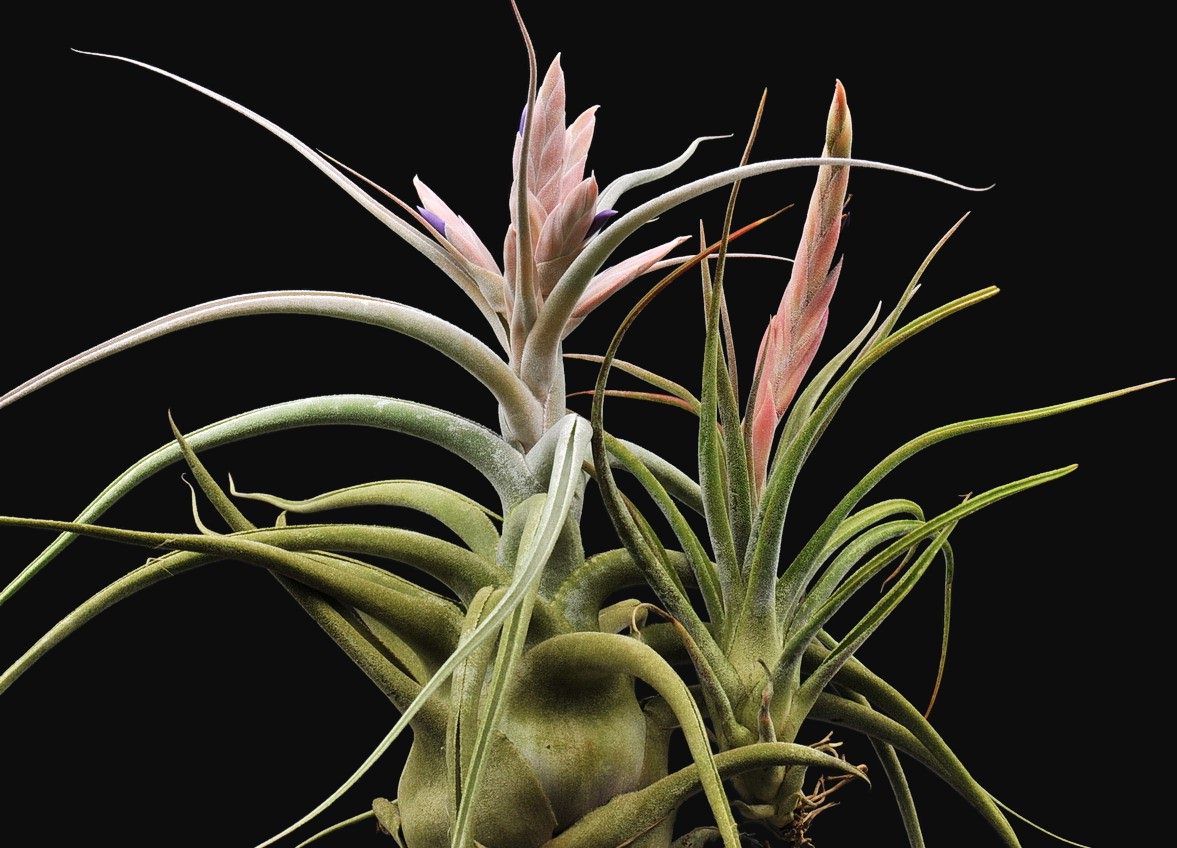
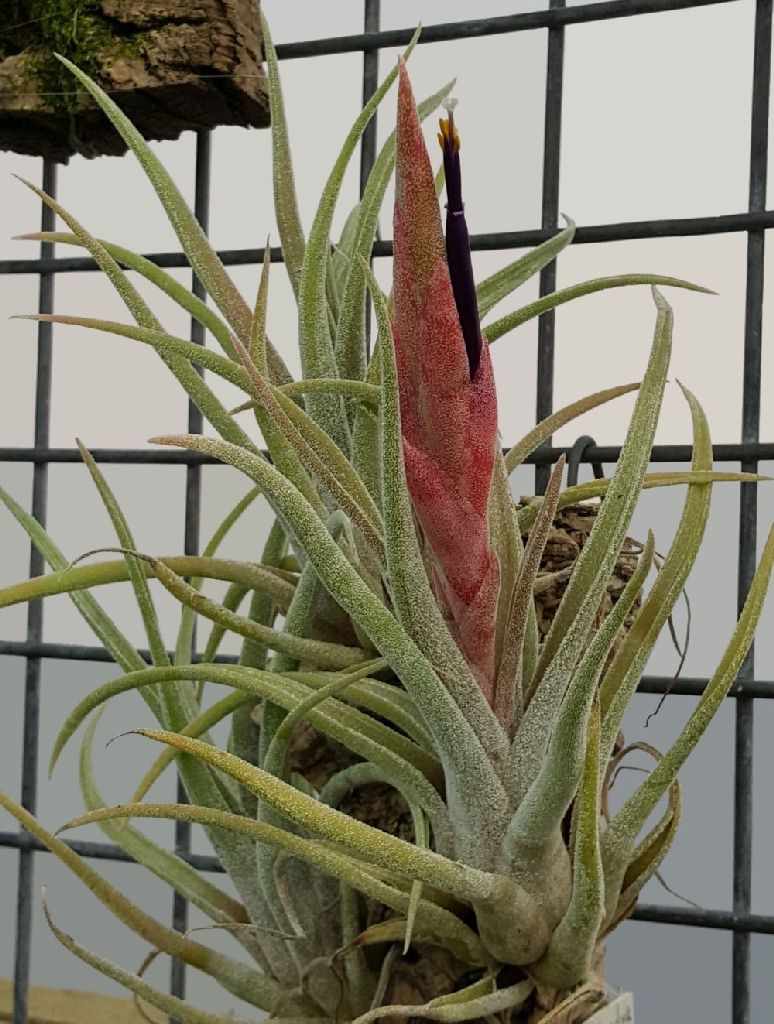
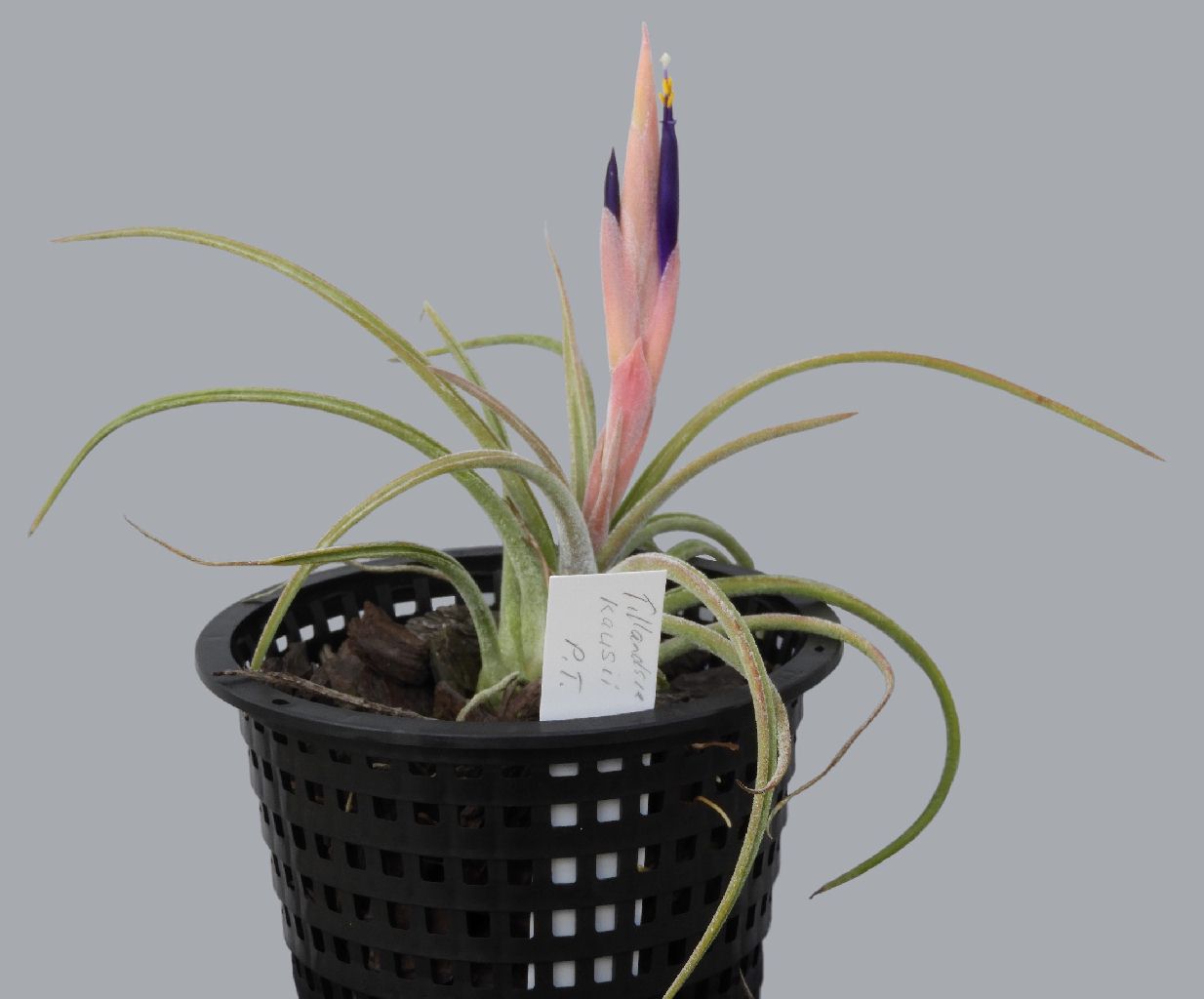
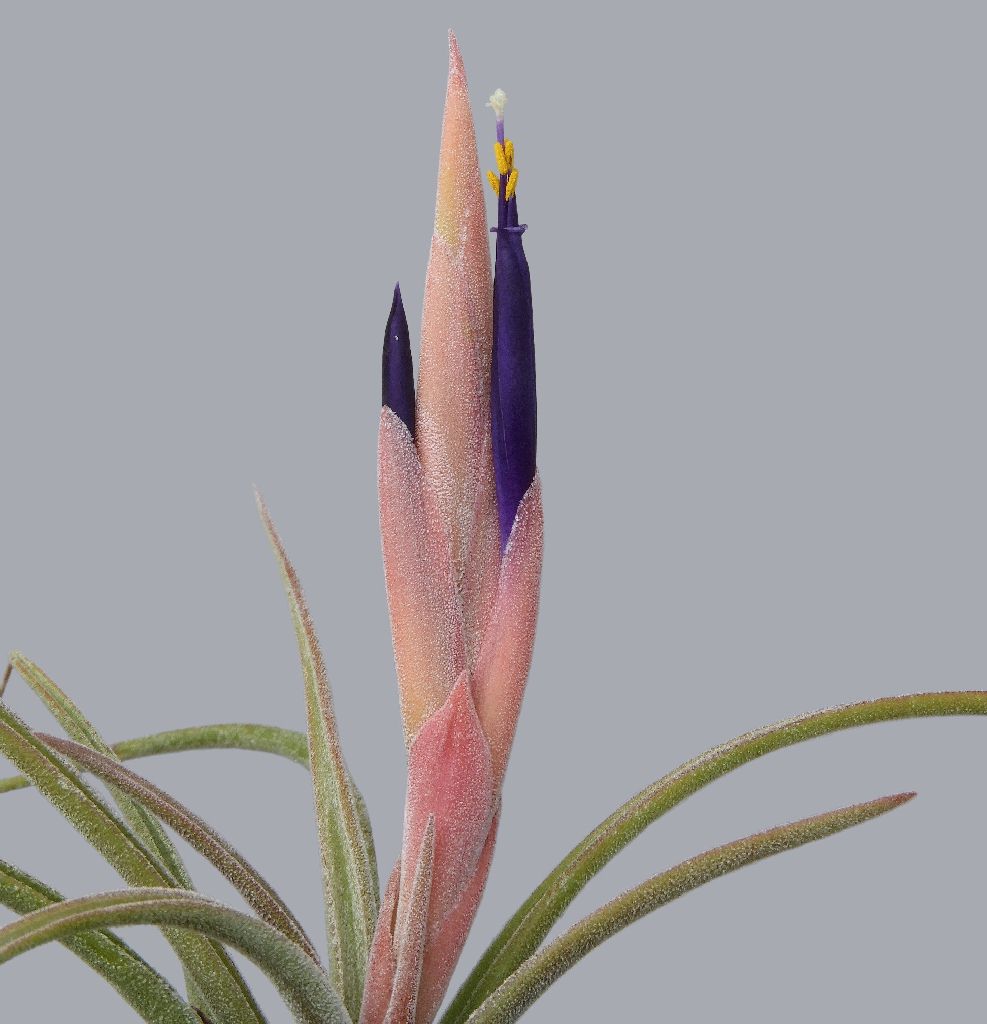
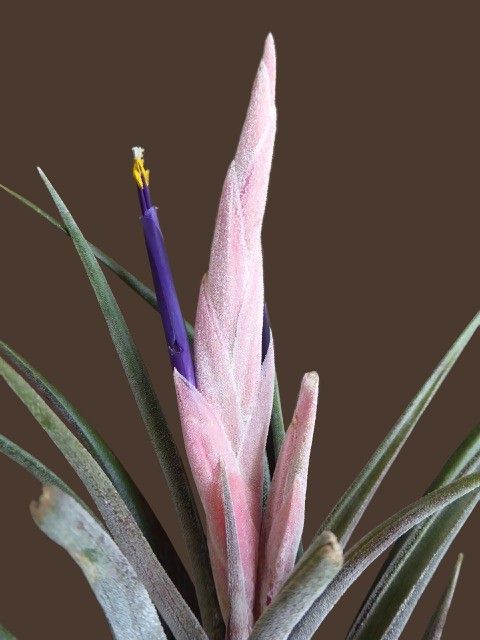
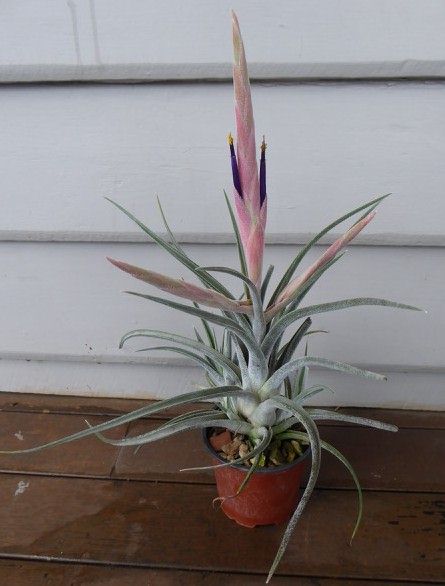
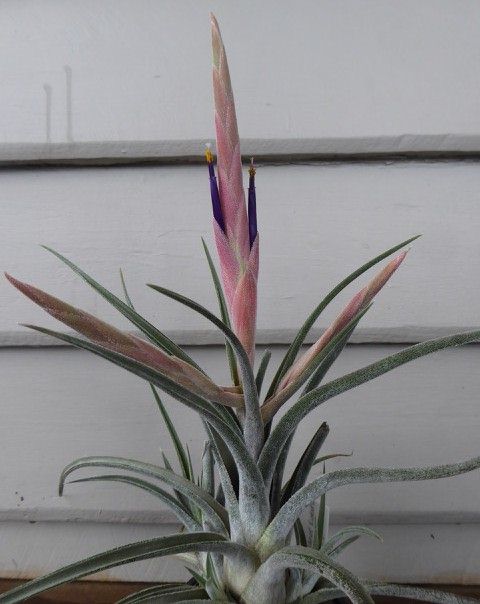
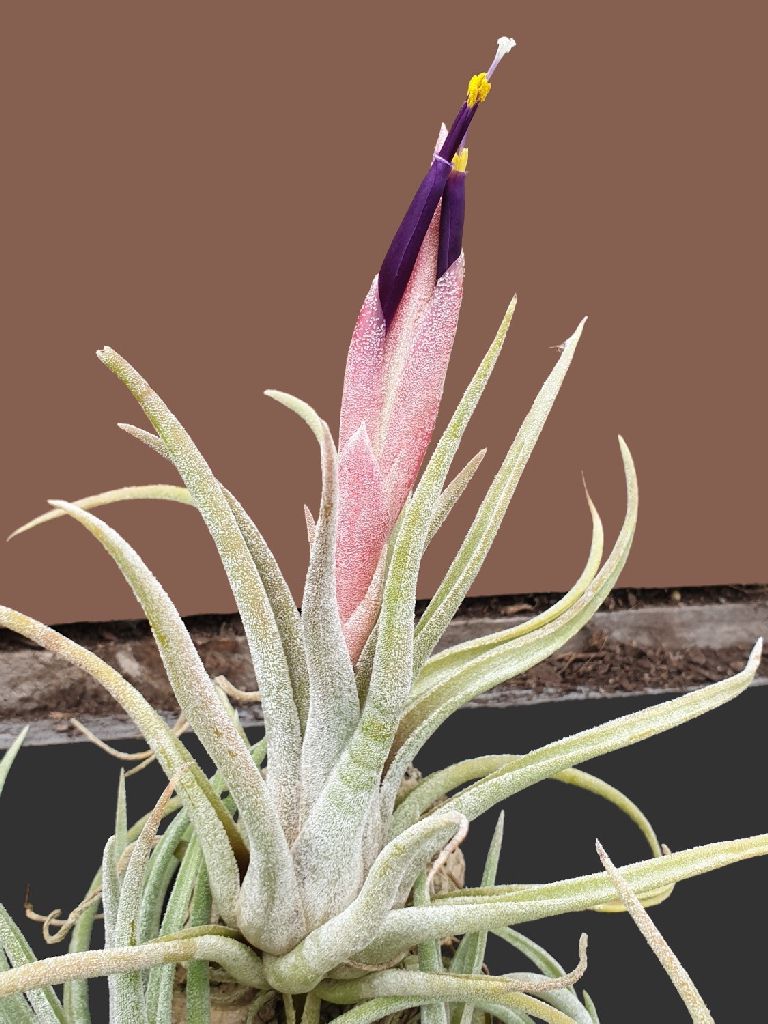
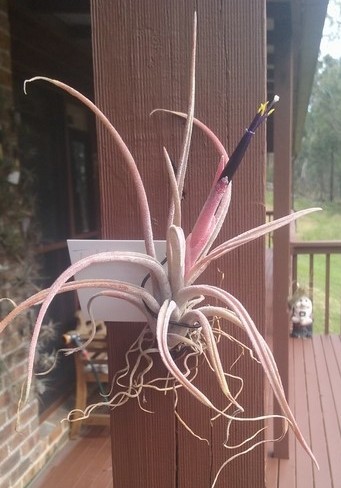
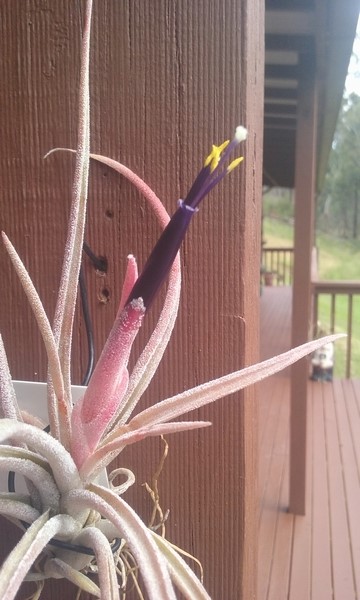
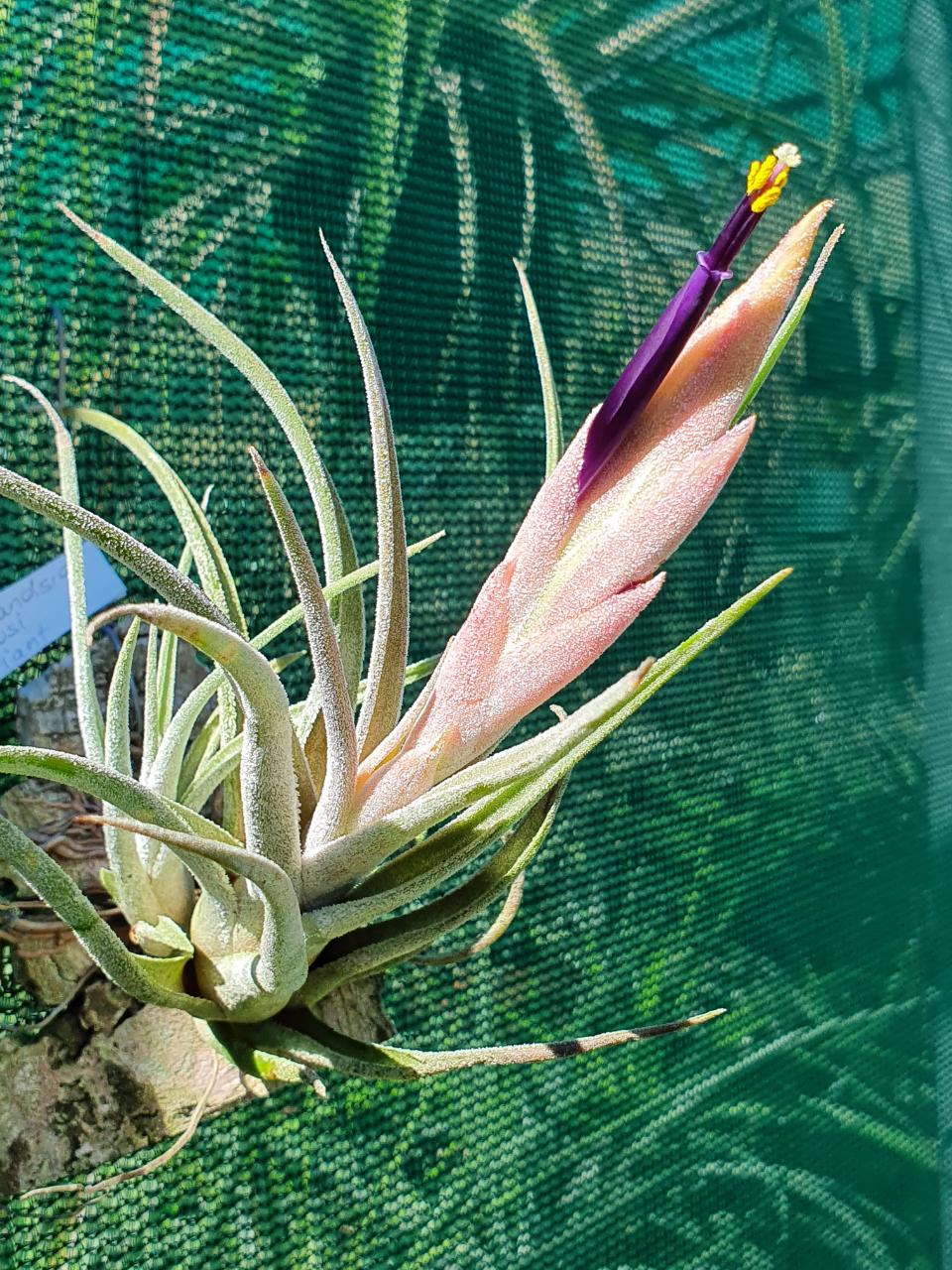
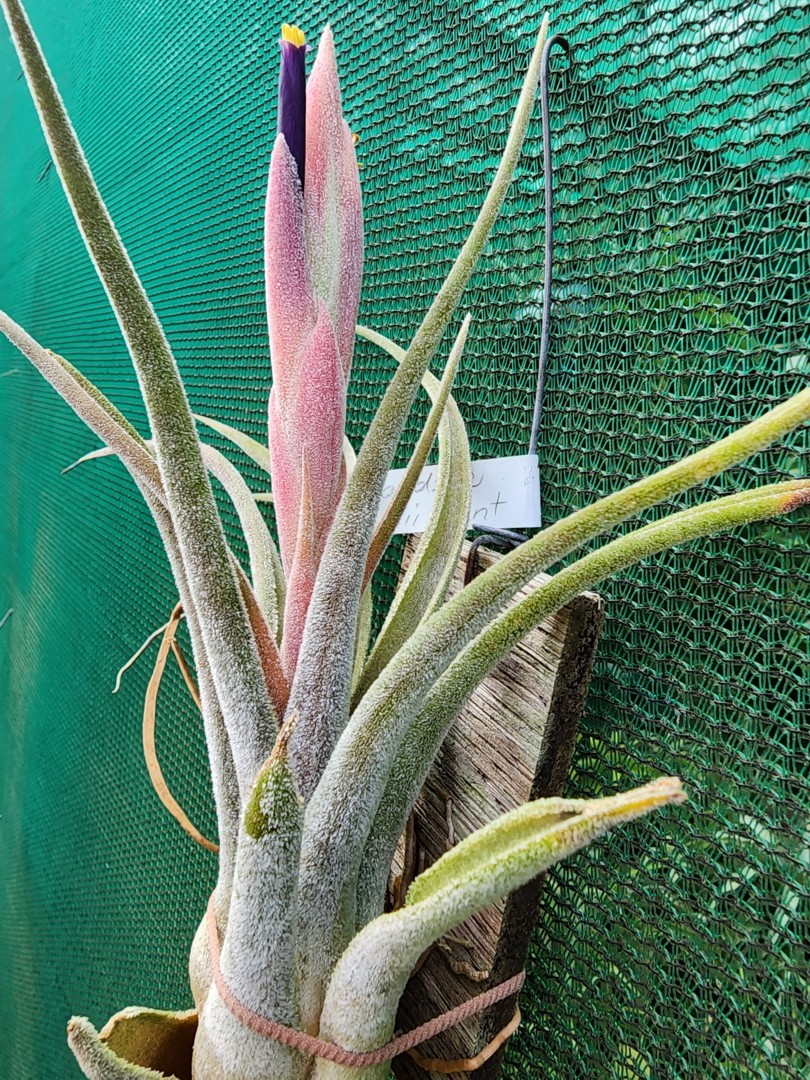
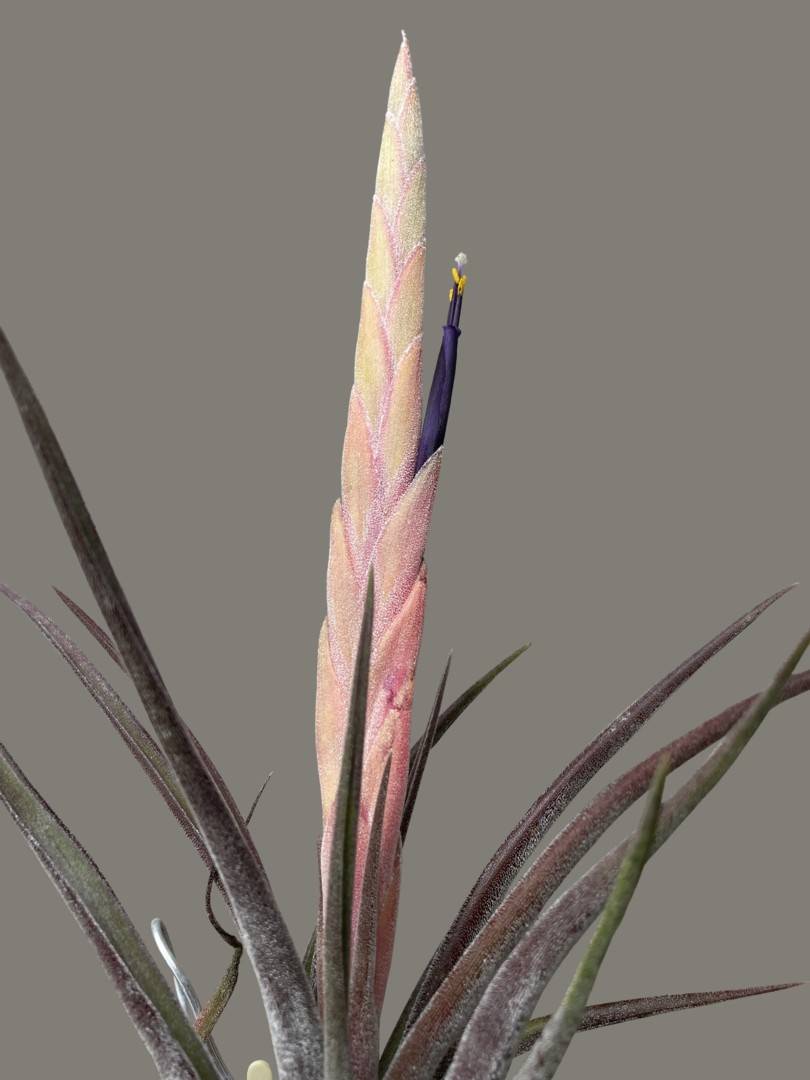
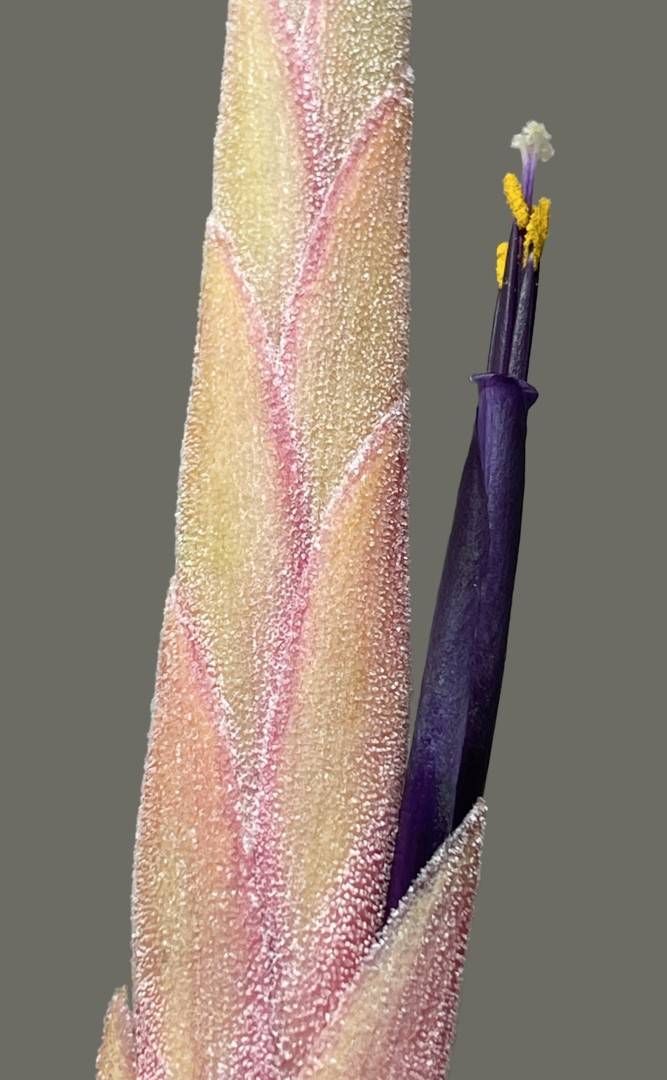
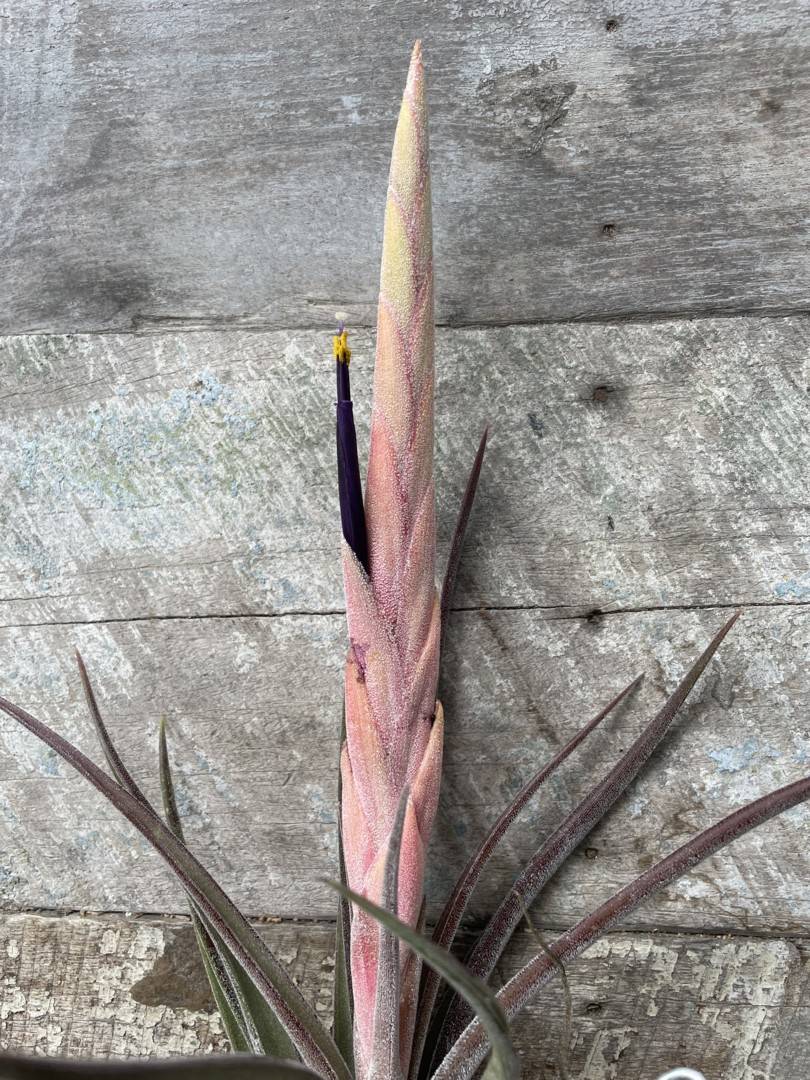
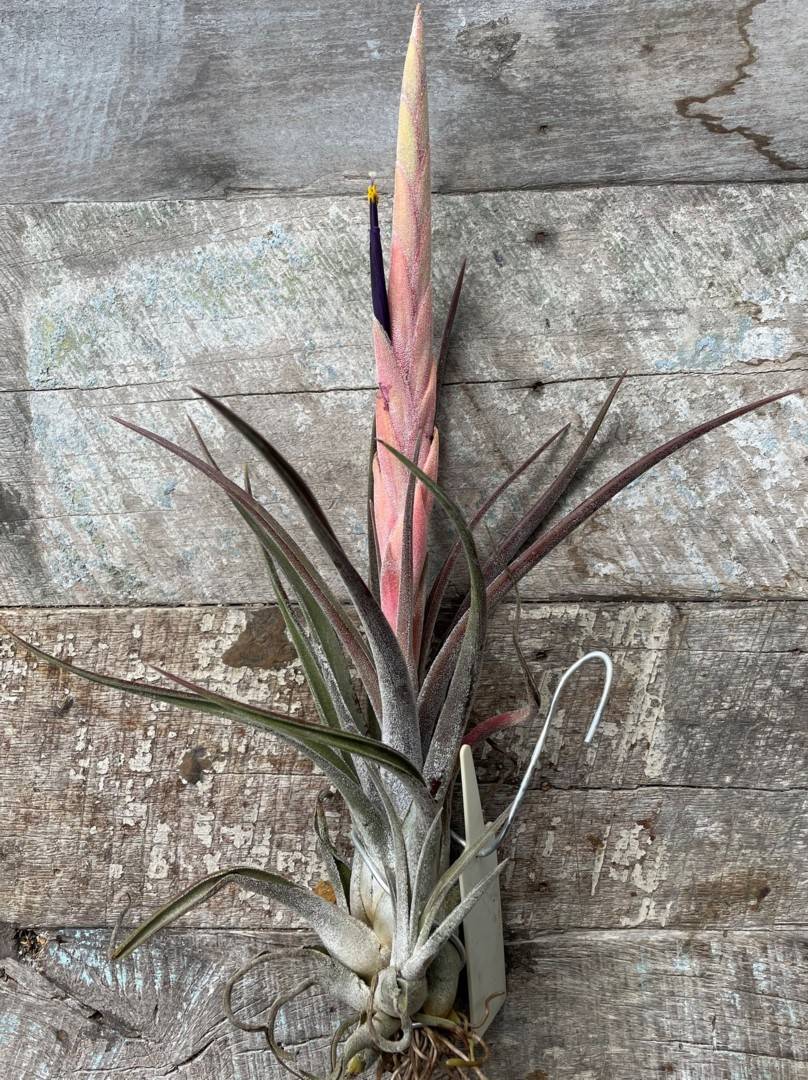
A Tillandsia chiapensis Gardner, cui affinis, foliis viridibus, erectis vel patentibus, non recurvatis, inflorescentia pauciflora, bracteis florigeris rubris, rariter atroroseis, sepalis paulo majoribus differt.
A T. mitlaensis Weber & Ehlers foliis patentibus, viridibus, sepalis minoribus minus connatis;
A T. schatzlii Rauh foliis pruinosis, inflorescentia pauciflora, pruinosa, bracteis florigeris paulo minoribus, sepalis minoribus minus connatis differt.
A T. paucifolia J .G. Baker foliis pruinosis non recurvatis, scapus inflorescen¬tiae breviter, bracteis florigeris majoribus, ecarinatis et pruinosis differt.
Plant stemless, flowering 15 cm high, growing in clumps.
Leaves few, forming a pseudobulbous rosette, exceeding the inflorescence, succulent, but soft and fragile, to 17 cm long, green, but rose to red in bright sun, densely covered with spreading, cinereous scales.
Sheaths broadly ovate, to 4 cm long, 3.5 cm wide, conspicuous, erect, inflated, adaxial surface brown or light brown, abaxial surface brown (or green in cultivation), densely gray lepidote on both sides.
Blades narrowly triangular to linear, to 13 cm long and 2 cm wide, involute-subulate, the margins nearly touching each other, bearing asymmetrical scales, densely gray lepidote on both sides, erect or spreading, recurved when dehydrated.
Scape erect, very short, only 1-2 cm long, 7 mm thick, round, hidden in the rosette.
Scape bracts few, similar to the floral bracts but smaller, erect, densely imbricate, elliptical, short acuminate, to 3.5 cm long, green-rose, densely lepidote.
Inflorescence erect, bipinnate, spike elliptic, complanate, 3-8 cm long, to 22 mm wide, 2- 7 sessile flowers lacking fragrance.
Floral bracts densely imbricate, concealing the rachis, erect, 3.5 cm long, up to 2 cm wide, 2-3 times longer than the rachis internodes, long elliptic-acute, more than 2 times longer than the sepals and covering them entirely, slightly nerved, ecarinate, abaxially rose or red, densely lepidote, adaxially green-rose, glabrous at base, apex laxly lepidote.
Sepals light green, subcoriaceous, glabrous, nerved, the posterior ones sharply carinate, subfree (ca. 1 mm connate), up to 2.4 cm long and 5 mm wide, lanceolate, acute.
Petals 5 cm long, ligulate, base 4 mm wide, apex 10 mm wide, tubular-erect, the tips very slightly spreading (1 mm), the base (covered by the sepals) white, the upper half blue-violet.
Filaments exserted, 1 cm longer than the petals, up to 7 cm long, flat in cross section, upper part thicker and violet, towards the base becoming white and thin (concolorous with the petals), sometimes slightly twisted.
Anthers 3-4 cm long, 1 mm wide, yellow to light brown, subbasifixed to 1/3 fixed, versatile, pollen yellow.
Style ca. 7 cm long, at anthesis 8 mm longer than the filaments, thin, upper part violet, base white;
stigma white, erect, 3 mm high, 2 mm wide, lobes papillose and a little spreading.
Ovary light green, 6 mm high and 2.5 mm wide, conical with flat sides.
Distribution: Southern Mexico: Chiapas, near Tuxtla Gutierrez, highly localized on steep rocks.
Holotype: Mexico: Chiapas, near Tuxtla Gutierrez, 20 March 1985, leg. K. & R. Ehlers EM 851801 (WU).
At first glance, it seems that the new species could be related also to T. velickiana L.B. Smith. Sue Gardner (1982) treats this species as a synonym of T. matudae L.B. Smith: “A population sample of T. matudae from the type locality had specimens with both densely branched inflorescences and simple ones. Floral bracts varied from subglabrous to lepidote. Other collectors report some specimens with lavender petals although a white corolla is typical."
I also studied specimens from the type locality and from other places and fully agree with Sue Gardner. Using Dr. L.B. Smith's key (1977) I did not come to T. velickiana since the sheaths of T. klausii are darker and more contrasting with the blades, and the inflorescence is over 5 cm.
Dr. Walter Till, to whom I owe thanks for his cooperation, writes: "According to the classification of Sue Gardner (1982) this species belongs to 'group 1, subgroup 7' to which the following species have been assigned:
T. achyrostachys E. Morren ex Baker (inc. var. stenolepis L.B. Smith,
T. califanii Rauh,
T. chiapensis Gardner,
T. circinnatoides Matuda,
T. mitaensis Weber & Ehlers,
T. pueblensis L.B. Smith (excl. var. glabrior L.B. Smith),
T. schatzlii Rauh,
T. subulifera Mez, and
T. weberi L. Hromadnik and P. Schneider.
"Tillandsia achyrostachys with glabrous floral bracts and yellow-green petals and T. subulifera with floral bracts shorter than the sepals (when dry), and yellow-white petals seem to be a little isolated in that group. The other species all have violet petals, simple or rarely branched inflorescence, floral bracts much longer than the sepals, lepidote and ecarinate, with glabrous, nerved, carinate and acute sepals, the. stamens in two sets of unequal lengths. The differences are mainly in the habit, the proportions, the different dimensions of floral bracts and sepals, sepals carinate or ecarinate, and the colour."
T. paucifolia J.G. Baker was placed by Sue Gardner in her subgroup 5. In my opinion, the boundaries between subgroups 7 and 5 are sometimes indistinct and for that reason I added this species to Dr. Till's schedule which appears on the facing page.
Table 1. Comparison of sepals
| Species | Length (mm) | Shape | Indument | Nervation | Keel | Connation |
| T. achyrostachis | 26 | subacute | glabrous | str.nerv. | carinate | short connate |
| T. califani | 30 | subacute | glabrous | nerved | post.carinate | free or short connate |
| T. chiapensis | 15 | acute | glabrous | nerved | carinate | free or to 4mm connate |
| T. circinnatoides | 18 | acute | white lep, (glabrous) | nerved | carinate | equ. free |
| T. mitlaensis | 23-35 | acute | glabrous | nerved | post.carinate | 5mm connate |
| T. pueblensis | 20 | acute | glabrous | nerved | carinate | 6mm connate |
| T. schatzlii | 27-29 | subacute | sparsl.lep, (glabrous) | nerved | inconsp.carinate | to 3mm |
| T. .subulifera | to 22 | obtuse | adpressed lep. | nerved(consp.) | unknown | equ. free |
| T. weberi | 20 | acute | glabrous | slightly | carinate | 3-4mm |
| T. klausii | 17-24 | acute | glabrous | nerved | post.carinate | 1mm connate |
| (T.paucifolia) | 20 | acute | glabrous | nerved | carinate | connate |
| Species | Indument | Keel | Length(mm) |
| T. achyrostachys | abaxial glabrous | ecarinate | 25-34 |
| T. califanii | densely gray lepidote | ecarinate | (49-53) |
| T. chiapensis | dense lepidote | ecarinate | (30-48) |
| T. circinnatoides | dense. adpressed lepidote | ecarinate | to 23 |
| T. mitlaensis | lepidote | ecarinate | 32-45 |
| T. pueblensis | adpr. gray lepidote | ecarinate | 25-30 |
| T. schatzlii | dense. adpressed lepidote | ecarinate | (40)-60 |
| T. subulifera | dense. adpressed lepidote | apex car. | to 20 |
| T. weberi | lepidote | ecarinate | 25-30 |
| T. klausii | dense. spreading lep. | ecarinate | 30-50 |
| (T. paucifolia) | adpr. lepidote | ecarinate apex carin. | 20-30 |